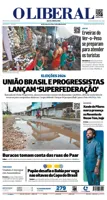Culture with Amazon DNA
From Marujada to tecnobrega, from Parintins to Sairé, cultural manifestations of the region carry the most diverse traditions of the forest and of the native peoples in their identity in addition to external influences, such as the Caribbean rhythm
If the Amazon is a cultural melting pot, it is certainly one that has never stopped boiling. No matter where… if in Parintins, Amazonas, Belém or Santarém, in the state of Pará, on all sides, the cultural formation of peoples directly dialogues with the art expressions that result from diverse connections and references, which flow into exuberant manifestations for one’s senses, especially those of vision and hearing.
Listen to the comment on this news:
The best-known artistic presentations in the Amazon have something in common: the connection between sound and visual dimensions, even if they carry different influences in their constitution, which may depend on the geographic location [the territory], native peoples and external interference.
The event of Marujada in the municipality of Bragança – Pará, for example, has its origins anchored in inheritances from the slavery period. The festivity which celebrates the city's patron São Benedito – ‘the black saint’ has its beginnings in the late 18th century, inspired in the permissive relationships between white masters and their slaves.
The religious festivity holds references to all these historical relationships, with heritages from different territories. The result is a singular local expression that mixes religiosity with a tradition of dance and music. The retumbão [afro-Brazilian dance], for example, a hallmark of the musical manifestation of Marujada. The retumbão combines instruments from different origins, such as the fiddle, the bass drum and the triangle; all of this is combined with the unique look of Marujada's traditional costumes, which have different colors depending on the day of the festivity. Families spend weeks dedicated to producing these garments. One of these outstanding elements of Marujada is the Marujas' [the female dancer’s] hat, which has delicate handmade flowers produced one by one with duck feathers.
Likewise, another event combines exuberant visuals with music: the Festival de Parintins [Parintins Folklore Festival], in Amazonas, where the Boi Garantido and Boi Caprichoso [respectively, the red and blue bulls] compete annually. The event, bearing the name of the island where it has been officially held since 1965, every month of June, involves parades full of visual elements and choreographies.
In the Amazon state, cultural references, origins and influences are also mixed. Caprichoso and Garantido are the bois-bumbá in the Amazonas state, a variation on the northeastern Brazilian bumba-meu-boi [traditional Brazilian folklore dance, which tells the story of a bull, mixing dance, music and theater] . And even though the music that sets the rhythm of the celebration is the toada [a genre which preserves African characteristics], parades and lyrics are always full of references to traditionally Amazonian narratives, leading to presentations by indigenous and forest figures, as well as those linked to the religiosity of native peoples.
The boi-bumbá also crosses borders and is represented in Pará by Arraial do Pavulagem [typical musical group from the state], which colors the streets of downtown Belém during the month of June and also at specific times of the year.
Another Amazonian festival that mixes religiosity with exalted expressions of folklore and traditions is Sairé [traditional religious procession which carries huge poles and religious rites], in Alter do Chão, Santarém, in western Pará. The celebration originated from Portuguese Catholic Jesuit missions, whose purposes was to evangelize native peoples such as the indigenous peoples – ended up becoming a celebration that speaks to Christianity, but also exalts elements of the religiosity of original peoples, such as the ‘enchanted beings’ from the forest, for example.
Something in common among most of these cultural manifestations, in addition to the existing connection between music and visual expressions, is the transformation they go through over time, remaining alive in contemporary days. If Marujada was born in the slavery period, today it can express a glimpse of racial representation within Eurocentric Christianity, without denying the origins of the black people in Brazil. Or, if the Festival de Parintins can be connected with the Brazilian northeast, it is difficult not to think of it as a contemporary representation of Amazonian peoples, as well as their yearnings. Likewise, if Sairé has its origins in the colonization period and process, today it also exalts elements of the culture of native peoples.
Different folklores, unique identity
The Amazonian cultural manifestations can be compared to the encounters of rivers, which come from different places and flow into unique identities in a never-ending movement. Musician Félix Robatto, who has researched the history of music in Pará and the origins of guitar playing highlights that the musical manifestations of the Amazon, even when they are not necessarily traditional expressions, carry influences and marks from the territory.
“Pará is, in fact, full of different folklore expressions, with different marks. There's the carimbó from the Salgado region, the carimbó from Icoaraci and from Marajó. There's also the lundu, the Marujada, the retumbão, and the Boi-Bumbá [typical dances or rhythmic variations]. Belém, the capital is also a melting pot. It seems to be the destination where all this flows to”, analyzes Félix.
The artist, who lives in the capital of Pará, believes that the meeting of all these references makes Belém a different territory for creation. “I think that all of this has a lot of influence on the creative process, on the interpretation of the cultural action”, he says.
Watch the Félix Robatto:
“I always say that bands here, even if they are not into regional work, they can make a difference just because they are from here. It's not a narrow minded or exhibitionist thought about Pará state being the best. The thing is: the way we face and think culture and creation is different. So much so that we sometimes see people performing the same musical genre, yet, with peculiar marks ,in such a way that the artist is hardly ever mistaken”, explains Félix.
Layse Rodrigues, vocalist of the group Layse e Os Sinceros, defends that this artistic production with the influence of territory as highlighted by Félix, also comes as a result of a learning process and from the contact with traditional cultural expressions. “It turns out that everything gets mixed up, because we learn to dance carimbó, we learn to dance lundu, and the other rhythms here”, she analyzes.
Layse carries in her artistic work, for example, the Bailes da Saudade [sort of nostaugic balls] , another manifestation where the encounter of references results in an environment that reveals the Amazonian identity.
Watch the Layse e Os Sinceros:
“The popular rhythms that come from Pará, such as carimbó and lundu, two patterns which combine stick drumming and string playing, mixed with the Caribbean radio influences that we had, originated our ground music – this drum music that is solid. The Caribbean influences that came with the guitar, with the merengue, the interference of romantic music, they all result in what Bailes da Saudade turned out to be”, says Layse.
The Future Scene: a multicultural Amazon
If there is contemporary Amazonian music, it is because there is the unquestionable vanguard. Since the territory is basically an inherent influence, it is possible to say that even when there is the intention of producing music focused on a world audience, the Amazonian artist carries, in his luggage, the exposure to a scenario full of cultural expressions, permeated by various influences that led to their formations.
This challenge of representing the vanguard of Pará music was taken on by some artists, including the well-known singer Gaby Amarantos in her recent album “Purakê”, which she describes as a proposition to reveal, under an artistic perspective, “a multicultural Amazon in the future”.
This connection between the traditional expressions and new references is also reflected in Layse's work, in a movement described by herself as extremely important, both in the experimentation aspect and in the preservation of traditional knowledge.
"Talking about the Amazon of the future, I think it is a modern way to face music with the influence that is coming from the countryside (...) There is the aparelhagem [typical dance balls from Pará that plays music in huge technological speakers]; there are music styles such as, lambada, carimbó, guitarrada..." - Félix Robatto, musician.
“One of the main reasons why my work is currently connected to it, lies in the fact that I am bounded to those masters of culture. I took part in some popular culture events with them. I represent the new generation and they represent theirs. I do not mean to teach them how new music styles from Pará are performed, instead, we menage to find a way to mix the traditional music and new influences that are reaching us”, says Layse.
Félix, on the other hand, highlights names that can also be representative as the edge of contemporaneous music and vanguard, besides Gaby Amarantos.
“Talking about the Amazon of the future, I think it is a modern way to face music with the influence that is coming from the countryside, besides the influence that is coming from the dance, which is something really strong in our ‘ball culture’ here. There is the aparelhagem [typical dance balls from Pará that plays music in huge technological speakers]; there are music styles such as, lambada, carimbó, guitarrada…, there are many artists who make different things here, such as Strobo, Bando Mastodontes, Móbile Lunar, Dois na Janela. Those are bands that do not exactly play regional music, but they perform their own style, their own mix. It is a broad issue to chat about in a bar for hours, so you could ask a lot of questions and get a lot of answers”, says Félix.
Carimbó, bregoso, techno and “cabocla opera” music styles
The Amazon popular culture also survives due to resistance. The number one challenge for the masters of culture is to perpetuate the identity traditions through the generations, since that occurs frequently just orally in a certain region. The next challenge to be accomplished is to be able to spread and value that culture beyond the borders of the north of Brazil, overcoming prejudice against the culture from one of the most socioeconomically abandoned regions in the country.
Pinduca, the king of Carimbó, an 84-year-old musician, who holds a career of over 70 years, has faced boos when he first started playing that regional rhythm in Belém in the early 70s. “Carimbó was considered to be a rhythm from the countryside, nobody would accept that in the big city. It was prohibited to be played in balls and parties”, he remembers.
The rhythm Pinduca brought to the urban center thrilled the artist in a side road in the municipality of Irituia, northeast of Pará: “I heard a beat coming from the woods. I and the musicians of my band went to see what it was. There was a shack house where people were dancing carimbó so intensely that they were sweaty. I got in and I kind of danced a little bit with them. That was the beginning of it all”, he recollects.
In 1973, when Pinduca launched his first album, with a record company from São Paulo, he surprised everyone announcing it would be a carimbó record. The album helped to popularize the genre, which started to be played in balls and brought along the dancers to perform it. “The youths started to dance carimbó in our shows”, Other carimbó masters came to perform in Belém as well.
Watch the Pinduca:
Pinduca has released 40 original carimbó albums. In 2014, the rhythm was recognized as a new item in the list of Brazilian cultural heritage, by the Instituto do Patrimônio Histórico e Artístico Nacional (Iphan) [National Historical and Artistic Heritage Institute]. In 2017, “No Embalo do Pinduca” [Pinduca’s beat] was nominated to the Latin Grammy Award in the category “Best Portuguese Language Roots Album”. Pinduca perfoms all over Brazil. He has also made shows in other Latin and European countries such as France, Germany and even in Africa. “Carimbó has become important in Brazil and in the world”, Pinduca says.
The singer Keila Gentil, 30 years old, was influenced by the culture of the outskirts in Belém. At the age of 18, she emerged as a composer and dancer, as a “B-girl” (hip hop dancer) as well as a grafitti artist and skater in Guamá neighborhood. She was the lead singer for the “Gang do Eletro” band for 8 years. That band has exported the music from the outskirts of Belém, such as “technobrega”.
Keila defines that music style as “the connection of bregoso music and the electronic beat”. Reaching great popularity, the rhythm has made her a prominent representative of the treme music [literally, “shake it”] in the stages. Treme is an evolution of the dance performed in the aparelhagem parties. “It is a pity that the movement has not continued. The outskirts dance has fought against negative retaliations”, she says.
Watch the Keila:
Keila started a solo career in 2018, keeping the same energy and the intense stage performance which have launched her nationally. She has performed in Lollapalooza music festival in 2018 and in Rock in Rio festival in 2019, including other festivals such as South by Southwes (SXSW) in the United States, Trans Musicales in France, Global in Denmark; and Lusotronics in Germany. “I keep on producing songs connected to the artists and outskirts from other places”, she says.
The resistance has given to the radio broadcaster Iracema Oliveira, 84 years old, the title of Master of Popular Culture, by Ministério da Cultura [Ministry of Culture] and by Fundação Cultural do Pará [Culture Foundation of Pará]. She is the guardian of Pássaro Junino Tucano [June Tucan Bird], responsible to maintain that typical folklore from Belém peripheral areas. Pássaro Junino Tucano is a popular musical theater, traditionally performed in São João festivals [Saint Joseph / hillbilly festivities], commonly seen on the streets, with adorned costumes, exclusive songs and a plot based on a bird being chased by a hunter. It is claimed that this “opera cabloca” has started during the Belle Epoque historical period in the 19th century, inspired by the great operas in Theatro da Paz in Belém, which was not affordable to the poor people.
Besides the popular tradition of “Birds”, Iracema also manages a group of Pastorinha [Nativity play] and a group Pará-folclórico [Pará folklore]. “I live for the art since 1945, when I was 7”, she tells. She learned it all from her father, Francisco Oliveira. Currently, there are 15 groups of ‘June birds’ in Belém. The Tucan is one of the oldest, founded in 1927. Two groups have been discontinued due to the guardian ladies’ death, turning that kind of cultural demonstration even rarer.
“Our desire was to perform the Pássaro Junino Tucano during the whole year, but there is no theater avaiable”, she regrets. The Pássaro Junino Tucano has 40 players, including children, young people and adults, which makes commuting difficult to other cities. “It is not about having a group, it is about promoting social work to the people, you have got to love it really, if there is no love for that culture you will not manage to preserve it”, Iracema states. The group is getting ready to record its songs for the first time.
Palavras-chave
COMPARTILHE ESSA NOTÍCIA

































